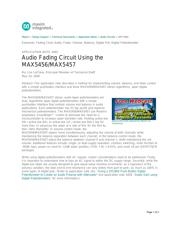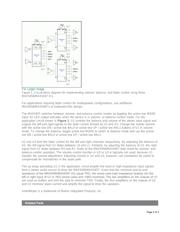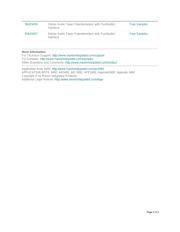下载

Attend this brief webcast by Maxim on
TechOnline
Maxim > Design Support > Technical Documents > Application Notes > Audio Circuits > APP 3492
Keywords: Fading Ciruit, Audio, Fader, Volume, Balance, Digital Pot, Digital Potentiometer
APPLICATION NOTE 3492
Audio Fading Circuit Using the
MAX5456/MAX5457
By: Jim LeClare, Principal Member of Technical Staff
May 23, 2005
Abstract: This application note describes a method for implementing volume, balance, and fader control
with a simple pushbutton interface and three MAX5456/MAX5457 stereo logarithmic, taper digital
potentiometers.
The MAX5456/MAX5457 stereo, audio taper potentiometers are
dual, logarithmic taper digital potentiometers with a simple
pushbutton interface that controls volume and balance in audio
applications. Each potentiometer has 32 tap points and replaces
mechanical potentiometers. The MAX5456/MAX5457 use Maxim's
proprietary SmartWiper™ control to eliminate the need for a
microcontroller to increase wiper transition rate. Holding active-low
DN / active-low BAL or active-low UP / active-low BAL1 low for
more than 1s advances the wiper at a rate of 4Hz for the first 4s,
then 16Hz thereafter. In volume-control mode, the
MAX5456/MAX5457 wipers move simultaneously, adjusting the volume of both channels while
maintaining the balance separation between each channel. In the balance-control mode, the
MAX5456/MAX5457 adjust the balance between channel 0 and channel 1, while maintaining the set
volume. Additional features include: single- or dual-supply operation, clickless switching, mute function to
-90dB (typ), power-on reset to -12dB wiper position, (THD + N) = 0.01%, and small 16-pin QSOP/TQFN
packages.
While using digital potentiometers with AC signals, certain considerations need to be addressed. Firstly,
it is important to understand how to bias an AC signal to within the DC supply range. Secondly, while the
digital pot steps are usually designed to give equal-value resistive increments, as a byproduct of the
process variation, the total end-to-end resistance can vary widely from part to part—as much as ±30% in
some types of digital pots. (Refer to application note 161, "Using a DS1802 Push-Button Digital
Potentiometer to Create an Audio Preamp with Attenuator" and application note 1828, "Audio Gain using
Digital Potentiometers" for more information.)
Page 1 of 3





